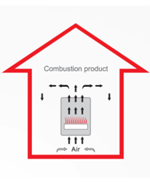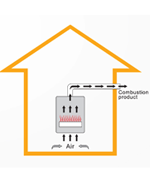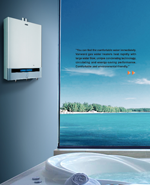Introduction:
1. By adopting an especially long heat transfer tube and a heat exchanger with large contact area with metal, China forced exhaust gas water heater fully transfers the burned gas heat to metal and warms up the water, and temperature of the exhausted gas is super low. The heat exchanger of residential gas geyser is with high thermal efficiency.
2. Compared with flue type, forced exhaust type is with one gas exhaust motor, and emits gas to the outside through flue forcedly, but the oxygen needed for combustion is still taken from indoor. Types of China Forced
Exhaust Gas Water Heaters from Vanward:
|
JSQ18-10SV56/JSQ20-12SV56/JSQ28-16SV56
|
JSQ20-10ST56/JSQ24-12ST56/JSQ30-16ST56
|
|
JSQ20-10G36/JSQ24-12G36/JSQ32-16G36
|
JSQ16-8C26/JSQ20-10C26/JSQ24-12C26
|
|
JSQ16-8M50/JSQ20-10M50
|
JSQ16-8M30/JSQ20-10M30
|
|
JSQ32-16P5
|
JSQ18-10SV16/ JSQ20-12SV16
|
|
JSQ16-8C2/JSQ20-10C2
|
JSQ30-16ET53
|
|
JSQ12-6C/JSQ16-8C
|
JSQ18-10ST16/JSQ20-12ST16
|
Structures:
1. Exhaust type forced exhaust gas water heater
Residential gas geyser replaces the anti-downdraft exhaust hood of flue type with exhaust device which includes gas collecting hood, electrical motor, exhaust blower and wind pressure switch, and transforms the original control circuit. Working principle: cold water enters and flows through filter, water-gas valve, and then reaches the gas nozzle. Exhaust motor sucks the air needed for combustion from inside, and gas gets burned out in the combustion room, high temperature gas gets cooled by heat exchanger, and then enters exhaust blower and gets emitted to the outside forcedly.
2. Blowing type forced exhaust gas water heater
Blowing type is very different from exhaust type in structure. Water enters and flows through filter, water switch and water tank heat exchanger, and gets heated as hot water. Gas enters the residential gas geyser, flows through filter, double magnetic valve and gas control valve, and then reaches gas nozzle. Air blower sucks the air needed for combustion from the inside directly, and presses the air and makes it enter the sealed combustor. Gas gets burned out, and high temperature gas gets cooled through heat exchanger, and then gets emitted to the outside through flue forcedly.
Features of Forced Exhaust Gas Water
Heater:
1. Gases are all emitted to the outside forcedly, to avoid polluting indoor air and ensure users’ safety.
2. Micro-positive pressure airtight combustor is adopted. Thickness of combustor is only half of that of flue water heater with same capacity, which enables residential gas geyser of large capacity with small size.
3. It replaces pressure-gradient gas water linkage device (mechanical) with water switch (electric control method). The improvement of control system simplifies the structure of water heater and makes it smaller.
Advantages of Forced Exhaust Gas Water Heater:
1. Leakage protection switch, power supply igniter, blower assembly and wind pressure switch are installed on the base of flue water heater, which enables forced gas exhaust.
2. Residential gas geyser is with functions of protections against accidental power off, blower fault, circuit overload and electric leakage.
3. It is easier to install the water heater, and safer for users, as the indoor environment makes little effect on heater.
4. It has strong capability in gas exhaust.
Vanward Products
Gas Water Heater
Comparison of three types of gas water heater

Comparison:
Flue Type
|
Forced Exhaust Type
|
Forced Exhaust and Air-Supply Type
|
Not safe enough
The combustion product generated during combustio is emitted directly to the bathroom, and the air for combustion is taken from the bathroom too. It is easy to cause CO poisoning and insufficient oxygen supply, so it can’t be installed inside the bathroom.
|
Much safer than flue type
The combustion product generated during combustion is emitted out of the bathroom through a flue, but the air for combustion is still taken from the bathroom, which may cause hypoxia. It is highly suggested not to install this type of gas water heater inside the bathroom. The difference between the flue type and forced exhaust type is that the forced exhaust type has a fan to forcedly blow or vacuum the combustion product out of the bathroom through a flue, but the China flue mounted gas water heater is to naturally emit the combustion product out of the bathroom with a flue (not included, optional). Therefore the evacuation of the combustion product of the forced exhaust type is more complete than that of flue type.
|
The safest of all
The combustion product generated during combustion is forcedly emitted out of the bathroom through a flue, meanwhile the air for combustion is forcedly inhaled from outside through the flue, so it wouldn’t consume or pollute the air inside. It is the safest and the only type that can be installed inside the bathroom.
|

|

|

|
The safest of all The combustion product generated during combustion is forcedly emitted out of the bathroom through a flue, meanwhile the air for combustion is forcedly inhaled from outside through the flue, so residential gas geyser wouldn’t consume or pollute the air inside. It is the safest and the only type that can be installed inside the bathroom.
Notes of Forced Exhaust Gas Water Heater:
1. There are mainly three gas sources. The first one is liquefied petroleum gas, namely canned gas; the second one is natural gas; and the third one coal gas. They are all transferred by pipeline. It is highly suggested to be clear which gas source you use before taking gas water heater.
2. Selection of gas water heater. Choose water heater with right capability of hot water supply (25℃ per minute) as per your needs. If your bathroom is small and with no bathtub, but just with shower, residential gas geyser with capacity of 6L per minute can meet your needs; if you bathroom is big and with bathtub, it would be better for you to choose water heater with capacity of 8L per minute
3. Chemistry, vent cup and anti-downdraft safety hood must be installed when installing water heater to get gas out of the room.
4. Due to the specificity of water heater, the manufacturer shall be with certain scale and ability. It is better to choose China forced exhaust gas water heater specified by local gas administrative department, which can provide you with better after-sales service.
5. Gas line cannot be dismantled or changed privately, as it is inflammable and explosive. Therefore, gas water heater shall be installed as per regulation of gas administrative department.
6. Gas water heater cannot be installed in the bathroom. Please study the instruction before installation and usage.
Care and maintenance of Forced Exhaust Gas Water Heater:
1. Check whether there is water leakage or gas leakage when turning on the inlet valve, outlet valve and gas valve. If there is, please stop using it for the moment, and inform repairer to get it repaired. Turn off the main gas valve (switch) immediately, and avoid ignite or pull plug when gas leakage occurs.
2. Check whether the exhaust pipe is aging or falling off, and whether the burned gas can be emitted through the flue.
3. Residential gas geyser uses power supply, so it is highly suggested not to use heater in thunder days. At the same time, it is better to pull the plug from the socket.
Typical type:
|
Rated heat load(kW)
|
18
|
20
|
28
|
|
Rated capability of hot water supply (△T=25℃)
|
10kg/min
|
12kg/min
|
16kg/min
|
|
Rated gas pressure
|
Liquefied petroleum gas 2800 pa
|
|
Natural gas 2000 pa
|
|
Manufactured gas 1000 pa
|
|
Control method
|
By outlet valve
|
|
Exhaust method
|
Forced type
|
|
Applicable water pressure (Mpa)
|
0.02~1.0
|
|
Gas entrance
|
G1/2 or G3/4
|
|
Cold water inlet
|
G1/2
|
|
Hot water outlet
|
G1/2
|
|
Package size(mm)
|
815×495×216
|
815×495×216
|
889×575×250
|
|
Gross weight/net weight(kg)
|
20/17.5
|
20/17.5
|
22.5/19.5
|
|
Container number 20'/40'/40'HQ
|
330/680/800
|
330/680/800
|
210/440/530
|















